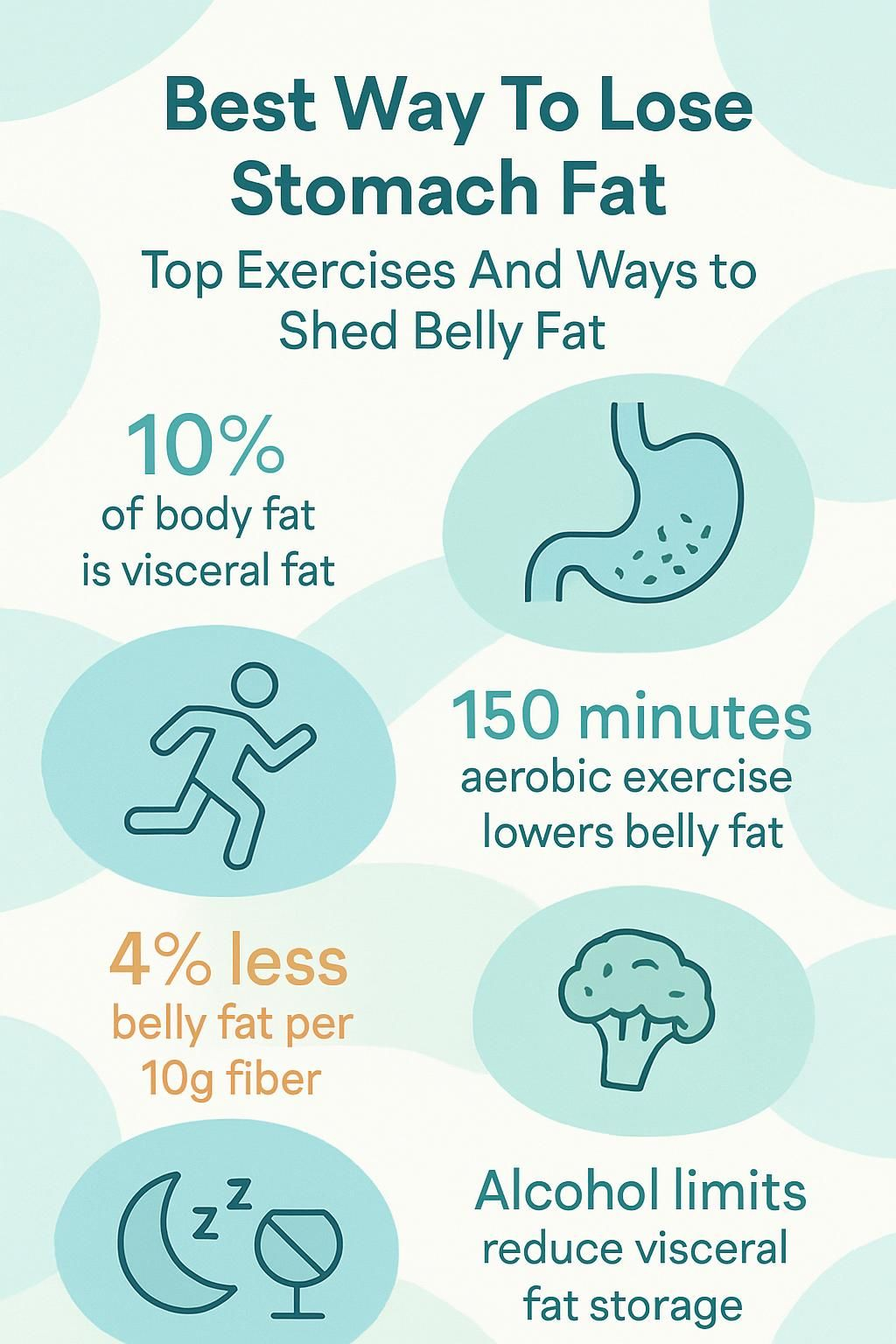Best Way To Lose Stomach Fat: Top Exercises And Ways To Shed Belly Fat
Our Nutrition Assistant AI Suite will transform your body. You will lose fat, get toned, and build muscle. Gain confidence and optimal health.
If you are trying to lose belly fat, you are in good company. Extra fat around your abdomen does more than change how you look. It raises the risk of heart disease and type 2 diabetes. The best results come from smart exercise, better food choices, and small daily habits that you can repeat.
This guide shows you exercises to help you lose belly fat, diet strategies that work, and lifestyle moves that reduce harmful visceral fat, which is fat around your organs. Simple steps, done often, can protect your health and your waistline.
Key Takeaways
- Visceral fat, about 10 percent of body fat, is strongly linked to heart disease, type 2 diabetes, and some cancers, based on Kaiser Permanente and Harvard research.
- Aerobic exercise for 150 minutes per week plus strength training twice weekly reduces total and visceral belly fat more effectively than ab exercises alone (Sports Medicine, 2022).
- Each extra 10 grams of soluble fiber per day is linked with about a 4 percent lower risk of gaining belly fat. Trans fats and refined carbs increase abdominal obesity.
- Sleeping less than 5 hours or more than 8 hours is tied to higher visceral fat. Aim to keep waist size under 35 inches for women and under 40 inches for men, per CDC guidance.
- Intermittent fasting and probiotic foods support gut health. Drinking less alcohol helps cut excess calories that drive visceral fat storage.

What is Belly Fat and Its Types

Belly fat is fat stored in your abdomen. It comes in two types, and knowing the difference helps you plan how to lose fat safely.
What is belly fat?
Abdominal fat, often called belly fat, builds up under the skin and deeper inside the abdomen. The two types are subcutaneous and visceral.
Subcutaneous fat sits under the skin. You can pinch it. It makes up most body fat.
Visceral fat sits deeper and wraps around your organs, including the liver, kidneys, and intestines. It is a smaller portion of total fat, yet it carries a higher health risk. These fat cells release hormones and chemicals that affect metabolism and raise the risk of insulin resistance and heart disease.
“Excess visceral belly fat can stiffen the omentum, change hormone activity, and raise disease risk.”
What is the difference between subcutaneous and visceral fat?
Subcutaneous fat is near the skin and feels soft. It stores energy and can produce some helpful molecules. Visceral fat sits deep in the abdominal cavity and presses tightly around internal organs. You cannot pinch it.
High visceral fat increases inflammation through cytokines, which are chemical messengers. It can also increase angiotensin, a substance that tightens blood vessels and raises blood pressure.
A tape measure gives a useful home estimate of visceral fat risk. Measure your waist at the navel level. For women, 35 inches or more signals excess belly fat. For men, 40 inches or more suggests higher risk.
Clinicians can measure visceral fat more precisely with CT or MRI. Even without scans, lifestyle steps like aerobic exercise, strength training, and balanced meals can lower this risk over time.
Why Is Belly Fat Harmful?
Carrying extra belly fat is not only a cosmetic concern. It raises your chance of chronic disease, mainly because visceral fat behaves like an active organ that disrupts normal function.
What health risks are linked to belly fat?
High visceral fat raises the likelihood of high blood pressure, abnormal blood fats, and fatty liver disease. It is linked to heart disease, type 2 diabetes, stroke, sleep apnea, and some cancers, including breast and colorectal cancer.
In a large European study, women with the largest waists had about double the heart disease risk. Every extra two inches around the waist increased cardiovascular risk by about 10 percent in healthy nonsmoking women. A California teachers study found women with waists over 35 inches were 37 percent more likely to have asthma, regardless of weight.
Visceral fat also triples the chance of colon polyps that can turn into cancer. Managing belly fat is a health priority, not just a body shape goal.
How does visceral fat contribute to chronic diseases?
Visceral fat produces substances that disturb how your body works. Angiotensin raises blood pressure. Cytokines drive inflammation, which plays a role in heart disease and insulin resistance.
High visceral fat is tied to metabolic syndrome, a group of problems that includes high blood sugar, high triglycerides, low HDL cholesterol, and elevated risk for type 2 diabetes and heart disease. A Kaiser Permanente study linked more abdominal fat in the early 40s with nearly triple the risk of dementia later in life.
Reducing visceral fat often improves blood sugar, blood fats, and blood pressure. That is why steady habits matter so much.
Effective Diet Strategies to Reduce Belly Fat
Food choices help shape your waistline. A plan that focuses on fiber, protein, and fewer refined carbs supports healthy fat loss and better body composition.
How does soluble fiber help reduce belly fat?
Soluble fiber slows digestion, helps you feel full longer, and can lower daily calorie intake. Studies show higher intake is linked with less visceral fat over time. One study found each extra 10 grams per day cut the risk of gaining belly fat by about 4 percent.
- Foods rich in soluble fiber: oats, beans, lentils, apples, oranges, carrots, and flaxseeds.
- Easy swap: choose oatmeal with fruit instead of white bread at breakfast.
This shift supports steady weight loss and helps reduce total body fat percentage.
Which foods contain harmful trans fats to avoid?
Trans fats raise heart risk and make losing fat harder. Look for the phrase “partially hydrogenated oils” on labels.
- Common sources: packaged cookies, crackers, microwave popcorn, some frozen pizzas, and certain fast foods.
- Hidden sources: some gravies, sauces, salad dressings, and spreads.
Comparing labels helps you pick options lower in trans fat and added sugar. Less of both usually means a smaller waistline.
Why should you reduce refined carbohydrates?
Refined carbs spike blood sugar and insulin, which can push your body to store fat around the waist. People eating fewer refined carbs often lose more abdominal fat.
In a Johns Hopkins study from 2012, a low-carbohydrate plan led to an average loss of 28.9 pounds in six months. Low-fat plans led to 18.7 pounds in that time. Whole grains digest more slowly and help control hunger and weight.
What are the benefits of high-protein foods for fat loss?
Protein increases fullness and helps you keep muscle while you lose weight. Keeping muscle is important, since muscle burns calories even at rest.
- Good sources: fish, chicken, turkey, eggs, beans, Greek yogurt, and low-fat dairy.
- Goal: include a protein source at each meal.
Higher protein, paired with fewer refined carbs, supports a lower body fat percentage and better results from training.
How do sugary drinks and processed foods affect belly fat?
Sugary drinks add fast calories and raise the risk of more intra-abdominal fat. Processed foods often pack added sugars, trans fats, and excess sodium, which can cause water retention and a larger waist.
Replace soda and sweetened juice with water or unsweetened tea. Choose whole foods most of the time. Reading labels helps you find and cut hidden sugars before they add inches.
Best Exercises to Lose Stomach Fat
Exercise burns calories, protects muscle, and helps reduce unhealthy fat around your waist. Mix aerobic exercise, intervals, and strength work for the best results.
What aerobic exercises help burn stomach fat?
Brisk walking, jogging, cycling, and swimming help your body use stored fatty acids from visceral fat. Aim for at least 150 minutes of moderate activity per week, or 75 minutes of vigorous activity.
Small moves add up. Take the stairs, walk during calls, or bike to nearby errands. Consistent aerobic exercise helps lower insulin levels and shrinks the waist over time.
How does High-Intensity Interval Training (HIIT) aid fat loss?
HIIT alternates short, hard efforts with brief recovery. It burns many calories in less time, and your body keeps burning after the workout ends.
A 2018 meta-analysis in Sports Medicine found HIIT reduced total and visceral fat. Try 30 seconds of hard cycling or sprinting, followed by one minute easy. Repeat for 15 to 20 minutes. Start modestly and build as your fitness improves.
Why include strength training and resistance exercises?
Strength training builds muscle mass, which raises daily calorie burn. Research in Sports Medicine (2022) shows that moderate resistance training helps reduce total and visceral fat.
- Plan for at least two sessions per week.
- Work major muscle groups: legs, back, chest, shoulders, and core.
Keeping muscle makes it easier to maintain a healthy weight and avoid regain after weight loss.
Which core exercises target belly fat effectively?
Core moves like planks, crunches, and sit-ups strengthen abdominal muscles and improve stability. They do not directly burn visceral fat, since spot reduction is not possible.
Combine core training with full-body cardio and strength work. This approach raises total calorie burn and supports fat loss across the body, including the midsection.
Lifestyle Changes That Support Belly Fat Loss
Daily habits influence hormones and hunger cues. A few steady changes can support your fat loss plan and make results stick.
How much sleep do you need to lose belly fat?
Most adults need 6 to 8 hours of sleep each night. Sleeping less than 5 hours, or more than 8, is linked with higher visceral fat, especially in people under 40.
Poor sleep raises cortisol, a stress hormone that promotes fat storage around the waist. Better sleep supports energy, appetite control, and healthier choices the next day.
What are effective stress management techniques?
Chronic stress can drive overeating and weight gain, especially around your abdomen. Calming routines lower stress and support better habits.
- Try deep breathing, short meditations, yoga, or gentle stretching.
- Walk most days, at least 30 minutes, to help mood and muscle maintenance.
- Limit caffeine late in the day and set a regular bedtime.
- Talk with a friend or keep a journal when stress builds.
People who manage stress tend to respond better to fat loss methods over time.
Why is consistent physical activity important?
Regular movement protects against weight regain and keeps waist size in a safer range. Targets for health risk reduction are under 35 inches for women and under 40 inches for men.
As you age, you may lose muscle. Consistent activity helps preserve lean tissue and makes weight control easier. Even simple actions like brisk walking or cycling, done often, improve results because visceral fat responds well to steady effort.
Summary Table: Benefits of Consistent Physical Activity
| Benefit | Supporting Data |
|---|---|
| Prevents regaining lost pounds | Long-term cohort data, CDC |
| Maintains a healthier waistline | Targets: under 35 in. women, under 40 in. men |
| Preserves muscle mass | Important during aging and menopause |
| Reduces hard-to-lose visceral fat | Supported by clinical trials |
Active days support organ health, better nutrient use, and more efficient calorie burning.
How Hydration Affects Fat Loss
Water is a simple tool for your plan. It supports metabolism, reduces liquid calories, and helps workouts feel easier.
Why is drinking water important for fat loss?
Replacing sugary drinks with water cuts calories fast. One daily soda can add about 150 calories. Swapping it for water can help you lose a pound in less than a month, with no other change.
Good hydration also supports blood flow during exercise and helps organs process nutrients. Choose water or unsweetened drinks most of the time to support your waistline.
What are the benefits of green tea and metabolism-boosting drinks?
Green tea contains catechins and caffeine that may increase calorie burning by about 3 to 4 percent per day in some studies. The effect is stronger when paired with regular exercise.
Oolong tea and black coffee can also aid fat use. Switching from soda to unsweetened tea can reduce cravings for sweet drinks and help reduce belly fat over time.
Science-Backed Tips to Shed Belly Fat
Some simple changes have solid evidence behind them. Use these ideas to support a smaller waist and better health.
How does intermittent fasting help reduce belly fat?
Intermittent fasting limits eating to certain hours. This often lowers calorie intake and can improve insulin control. During the fasting period, your body taps stored fat for energy, including visceral fat.
People who follow safe fasting schedules in research often lose more inches at the waist than those on standard calorie plans. Start with a gentle approach, such as 12 hours overnight, and expand if it fits your schedule.
What are probiotic-rich foods and their benefits?
Probiotics are live, helpful bacteria found in foods like yogurt, kefir, sauerkraut, kimchi, tempeh, and miso. They support a healthy gut microbiome, which is tied to weight control and lower inflammation.
Studies link regular probiotic intake with modest reductions in waist size across several weeks. If you do not eat dairy, choose plant-based fermented options.
Why should you eat fatty fish regularly?
Fatty fish such as salmon, sardines, and mackerel provide protein and omega-3 fats that support heart health. A 3-ounce serving of salmon has about 22 grams of protein.
Eating fatty fish two to three times per week can help preserve muscle during weight loss and may support fat loss compared with lower-fat patterns. Choose grilled or baked options instead of fried.
How does alcohol consumption affect belly fat?
Alcohol brings extra calories and slows fat burning, since your body uses alcohol for energy first. A 12-ounce beer has about 150 calories. A cocktail may have 300 or more.
Higher intake is linked with more visceral fat. Harvard data show men who have more than two drinks per day face a higher chance of increased belly fat. Cutting back can make your exercise and diet changes work harder for you.
Long-Term Strategies to Maintain Fat Loss
Keeping fat off is a daily practice. Simple routines and regular tracking help you stay on track without extreme rules.
Why is fat loss a lifestyle, not a quick fix?
Fast diets may change the scale for a short time, then weight returns. Slow, steady loss, about one to two pounds per week, is safer and more sustainable.
Focus on whole foods like vegetables, fruits, lean proteins, whole grains, and nuts. Pair them with regular exercise to build and protect muscle. This steady approach reduces visceral fat and supports long-term health.
How can building healthy habits help maintain fat loss?
Habits reduce decision fatigue and make progress automatic. Keep healthy snacks handy, plan balanced meals, and schedule activity like any appointment.
Social support helps. Share goals with a friend, join a walking group, or set up a weekly strength session. Clothing fit, energy, and mood are useful signals, not just the scale.
What is the best way to monitor fat loss progress?
Measure your waist at the navel with a soft tape. Stand tall, keep the tape level, relax, and exhale before reading the number. Measure at the same time of day each time.
A healthy waist is 35 inches or less for most women and 40 inches or less for most men. Checking every two weeks shows trends better than daily scale checks and keeps you focused on what works.
Common Myths About Losing Belly Fat
Myths can waste your time and energy. Clear facts help you choose what actually works.
Is spot reduction of belly fat possible?
No. You cannot force fat loss from one body part with targeted exercises. Fat loss comes from a sustained calorie deficit. Genetics decides where you lose fat first.
Ab exercises strengthen muscles but do not remove visceral fat by themselves. People lose more belly fat with full-body exercise plus healthy eating than with core work alone.
Are fat-burning supplements effective?
Claims are strong, but quality evidence is weak. No supplement has been proven to target belly fat better than diet and exercise.
Many products contain stimulants that raise heart rate or cause side effects. Spend your effort on protein-rich meals, fiber, and consistent training. These are proven and safer.
Frequently Asked Questions
Here are clear answers to common questions about reducing belly fat and protecting your waistline.
What is the fastest way to lose belly fat?
Combine a lower-carb eating plan, aerobic exercise, and strength training. The 2012 Johns Hopkins study showed larger weight loss from low-carb plans than low-fat plans over six months. Cut sugary drinks, avoid trans fats, and choose whole foods rich in protein and fiber.
Sleep 6 to 8 hours nightly. Poor sleep makes weight control harder and increases cravings.
How long does it take to see belly fat loss results?
Many people notice small waist changes within a few weeks of steady habits. Research shows meaningful weight loss by six months with a lower-carb plan and regular activity.
Clothes often fit better before the scale moves a lot. Aim for steady progress and keep your focus on habits that last.
Can you reduce belly fat without exercising?
Yes, diet alone can reduce calories and shrink your waist, but progress is usually slower. Emphasize vegetables, lean protein, whole grains, and water. Limit refined carbs, sugary drinks, and processed snacks.
Exercise speeds results, protects muscle, and helps maintain weight loss. Pairing both gives the best outcome.
Conclusion
Losing belly fat takes a clear plan and repeatable habits. Build meals around protein and high-fiber foods, such as lean meats, beans, yogurt, vegetables, and fruit. Choose water or green tea instead of sugary drinks. Aim for 150 minutes of aerobic exercise each week and add strength training twice weekly.
Sleep 6 to 8 hours, manage stress, and measure your waist regularly. Keeping it under 35 inches for most women and under 40 inches for most men lowers health risk linked to visceral fat. If you have a medical condition or take medications, talk with your healthcare provider before starting any new diet or exercise plan. With steady effort, you can lose belly fat, improve your health, and feel more confident.
FAQs
1. What are the most effective exercises to lose stomach fat and trim your waistline?
Aerobic activities such as brisk walking, cycling, and swimming help burn calories and reduce belly fat. Strength training also supports muscle growth around the waistline, which increases metabolism.
2. Can eating nuts (fruit) help with losing stomach fat?
Nuts like almonds or walnuts provide healthy fats, protein, and fiber that can support weight loss when eaten in moderation. Studies show that including nuts (fruit) in a balanced diet may improve satiety and assist with reducing overall calorie intake.
3. How does clothing choice affect my waistline during exercise?
Wearing comfortable workout clothing allows for better movement during physical activity targeting the waistline area. Proper attire can enhance performance by preventing restriction while exercising.
4. Are there scientific studies supporting these methods for shedding belly fat?
Research published in journals such as Obesity Reviews highlights aerobic exercise’s role in decreasing abdominal adiposity. Nutritional data from sources like the USDA confirm that moderate nut consumption aligns with improved body composition outcomes.
Summary: Aerobic workouts combined with strength training target stomach fat effectively while proper nutrition including nuts (fruit) aids satiety and calorie control; suitable clothing enhances exercise efficiency around the waistline; credible research supports these strategies for reducing belly fat.







